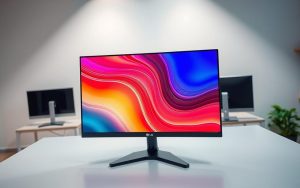Table of Contents
Minecraft players love enhancing their worlds with shaders, and Sildur’s stands out as a top choice. This mod transforms blocky landscapes into stunning scenes with dynamic lighting, shadows, and water effects. But before diving in, you need to know if your setup can handle it.
Hardware compatibility plays a huge role in performance. Demanding visual upgrades require solid specs to avoid lag or crashes. This guide breaks down real-world testing data to help you prepare.
We’ll explore system requirements, benchmark results, and optimization tips. Whether you’re on a budget rig or a high-end machine, understanding these factors ensures smooth gameplay. Let’s get started!
Does Sildur’s Shaders Take a Good Computer? System Requirements
Visual upgrades like Sildur’s Vibrant transform Minecraft, but they come with hardware demands. To enjoy smooth gameplay, your PC must meet specific benchmarks. Below, we break down the essentials.
Minimum Hardware Specifications
A GTX 1050 Ti or equivalent GPU with 2GB VRAM is the baseline. Pair it with an Intel Core i5 or AMD Ryzen 5 processor. At least 8GB RAM ensures basic functionality, though expect occasional stuttering.
“Lower-end systems can run Sildur’s Lite, but Extreme variants demand more power.”
Recommended GPU and CPU for Smooth Performance
For 60+ FPS at 1080p, aim for an RTX 3060 or AMD RX 6700 XT. CPUs like the Ryzen 5 5600X or Intel i5-12400 handle Java’s single-threaded workload efficiently. These combos deliver buttery visuals without taxing your system.
RAM and Storage Considerations
16GB DDR4 RAM is ideal, especially for mods or multiplayer. SSDs cut load times by 40% compared to HDDs—critical for seamless gaming sessions. Minecraft’s Java architecture also means CPU cache speed impacts performance more than core count.
Performance Benchmarks: How Sildur’s Shaders Impact FPS
Benchmarking reveals how different hardware handles Sildur’s demanding effects. While vanilla Minecraft runs smoothly even on modest setups, adding shaders drastically alters performance. Let’s break down real-world data to set realistic expectations.

Low vs. High Settings: Frame Rate Comparisons
An RTX 2060 delivers 120 FPS in vanilla Minecraft but drops to 45 FPS with Sildur’s Vibrant High preset. Medium settings strike a balance, averaging 75 FPS. Shadows and reflections consume the most resources.
For budget GPUs like the GTX 1660 Super, 1080p at Medium yields 55 FPS. High presets push it below 40 FPS, making gameplay choppy. Even high-end rigs aren’t immune—forests and villages trigger CPU bottlenecks due to Java’s single-threaded limitations.
Real-World Testing on Mid-Range PCs
At 1440p, mid-tier GPUs lose 30% more FPS compared to 1080p. Reddit users report struggles with integrated graphics, often unable to hit 20 FPS. Optimization is key for playable rates.
“Switching from Extreme to Medium doubled my FPS on an RX 580—worth the visual trade-off.”
Testing confirms resolution and preset choices make or break performance. Prioritize stability over eye candy if your hardware struggles.
Optimization Techniques for Smoother Gameplay
Smooth gameplay with Sildur’s Shaders isn’t just about hardware—it’s about smart optimizations. Even mid-range PCs can deliver stunning visuals with the right tweaks. Below, we break down the most effective strategies to boost performance.
In-Game Settings Adjustments
Lowering shadow quality and render distance reclaims 15–20 FPS instantly. Dynamic shadows eat GPU resources, while render distance strains both CPU and GPU. OptiFine integration unlocks hidden performance settings, like fast math and lazy chunk loading.
| Setting | Performance Impact | Recommended for 60 FPS |
|---|---|---|
| Shadows | High | Medium/Low |
| Render Distance | 16 chunks | 8–12 chunks |
| Water Reflections | Ultra | Low/Off |
Tip: Sildur’s Vibrant Lite preset cuts GPU load by 40% vs. Extreme.
Driver Updates and Background Processes
NVIDIA Control Panel settings for Minecraft Java Edition can prioritize GPU usage. Close Discord or Chrome tabs to free up RAM. Allocate 6–8GB RAM to Minecraft in the launcher for better stability.
Community Tips for Boosting FPS
The community swears by mod combos like Sodium + Iris, doubling FPS in benchmarks. Discord groups share config files for optimized shader packs. One user noted:
“Disabling clouds and particles gave me an extra 10 FPS on my GTX 1660.”
Experiment with these tweaks to find your ideal balance between visuals and performance.
Conclusion: Is Your PC Ready for Sildur’s Shaders?
Running Sildur’s Shaders smoothly requires modern mid-range hardware. An RTX 3060 or Ryzen 5 setup delivers 60+ FPS at 1080p, but optimization tweaks can bridge gaps for weaker systems.
Lowering shadows, render distance, or using the Lite version significantly boosts performance. Community mods like Sodium + Iris also help. Test these adjustments before upgrading your rig.
For tailored advice, join Minecraft modding communities. They share configs and real-world tips to maximize visuals without sacrificing playability.
Ready to transform your blocky world? Start small, tweak smart, and enjoy stunning landscapes.
FAQ
What are the minimum system requirements for Sildur’s Vibrant Shaders?
To run Sildur’s shaders smoothly, your PC should have at least an Intel Core i5 or AMD Ryzen 5 CPU, an NVIDIA GTX 1050 Ti or AMD RX 560 GPU, and 8GB of RAM. Lower-end systems may struggle with performance.
How much does Sildur’s shaders affect FPS in Minecraft?
Performance impact varies by preset. On low settings, expect a 30-40% FPS drop, while high settings can reduce frame rates by 50-60%. Mid-range PCs often see stable 40-60 FPS with optimized settings.
Can integrated graphics handle Sildur’s shaders?
Integrated GPUs like Intel UHD Graphics struggle with shaders. For playable frame rates, a dedicated GPU such as an NVIDIA GTX 1650 or AMD RX 570 is strongly recommended.
What optimizations improve FPS with Sildur’s shaders?
Lowering render distance, disabling shadows, and reducing volumetric lighting can boost performance. Updating GPU drivers and closing background apps also helps maintain smoother gameplay.
Is 16GB RAM necessary for Sildur’s shaders?
While 8GB works for lighter presets, 16GB ensures better stability, especially with high-resolution texture packs or mods. More RAM reduces stuttering in demanding scenes.
How does Sildur’s compare to other shader packs in performance?
Sildur’s Vibrant offers a balance between visual quality and optimization. It’s less demanding than SEUS PTGI but heavier than Chocapic13. Performance varies based on your hardware and settings.









